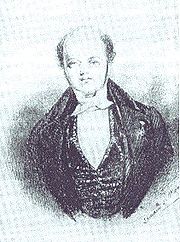
Benjamin Valz
Encyclopedia

France
The French Republic , The French Republic , The French Republic , (commonly known as France , is a unitary semi-presidential republic in Western Europe with several overseas territories and islands located on other continents and in the Indian, Pacific, and Atlantic oceans. Metropolitan France...
astronomer
Astronomer
An astronomer is a scientist who studies celestial bodies such as planets, stars and galaxies.Historically, astronomy was more concerned with the classification and description of phenomena in the sky, while astrophysics attempted to explain these phenomena and the differences between them using...
.
He was born in Nîmes
Nîmes
Nîmes is the capital of the Gard department in the Languedoc-Roussillon region in southern France. Nîmes has a rich history, dating back to the Roman Empire, and is a popular tourist destination.-History:...
and trained as an engineer. He became interested in astronomy
Astronomy
Astronomy is a natural science that deals with the study of celestial objects and phenomena that originate outside the atmosphere of Earth...
and comet
Comet
A comet is an icy small Solar System body that, when close enough to the Sun, displays a visible coma and sometimes also a tail. These phenomena are both due to the effects of solar radiation and the solar wind upon the nucleus of the comet...
s in particular, observing the return of what would later be named Comet Encke
Comet Encke
Comet Encke or Encke's Comet is a periodic comet that completes an orbit of the Sun once every three years — the shortest period of any known comet...
. He later made a very complete calculation of the orbital elements
Orbital elements
Orbital elements are the parameters required to uniquely identify a specific orbit. In celestial mechanics these elements are generally considered in classical two-body systems, where a Kepler orbit is used...
of another comet, for which he won recognition.
In 1835 he hypothesized that irregularities in Comet Halley
Comet Halley
Halley's Comet or Comet Halley is the best-known of the short-period comets, and is visible from Earth every 75 to 76 years. Halley is the only short-period comet that is clearly visible to the naked eye from Earth, and thus the only naked-eye comet that might appear twice in a human lifetime...
's orbit could be explained by an unknown planet beyond Uranus
Uranus
Uranus is the seventh planet from the Sun. It has the third-largest planetary radius and fourth-largest planetary mass in the Solar System. It is named after the ancient Greek deity of the sky Uranus , the father of Cronus and grandfather of Zeus...
—at the time, Neptune
Neptune
Neptune is the eighth and farthest planet from the Sun in the Solar System. Named for the Roman god of the sea, it is the fourth-largest planet by diameter and the third largest by mass. Neptune is 17 times the mass of Earth and is slightly more massive than its near-twin Uranus, which is 15 times...
was not yet discovered.
He built a private observatory at his home and when he went to take up a post as director of the Marseille Observatory
Marseille Observatory
Marseille Observatory or Observatoire de Marseille is an astronomical observatory run by the University of Provence. It is located near Marseille, France. In its first incarnation, it was the discovery site of a group of galaxies known as Stephan's Quintet or Hickson 92, discovered by Édouard...
, he left his home to a young man named "A. Laurent
A. Laurent
A. Laurent was a Frenchman who discovered the asteroid 51 Nemausa in 1858.He never made any more asteroid discoveries and not much more seems to be known about him...
", who used the observatory to discover the asteroid
Asteroid
Asteroids are a class of small Solar System bodies in orbit around the Sun. They have also been called planetoids, especially the larger ones...
51 Nemausa
51 Nemausa
51 Nemausa is a large asteroid-belt asteroid similar to 1 Ceres in composition. It was discovered by one "A. Laurent", an obscure figure about whom little is known. Laurent made the discovery from the private observatory of Benjamin Valz in Nîmes, France. The house, at 32 rue Nationale in Nîmes,...
. The house, at 32 rue Nationale in Nîmes, has a plaque commemorating the discovery. http://www.netnimes.com/centre_ville_8.htm
Valz himself was at one time said to be the discoverer of two asteroids, 20 Massalia
20 Massalia
20 Massalia is a large and fairly bright main-belt asteroid. It is also the largest member of the Massalia family of asteroids. Its name is the Greek name for Marseille, the city from which one of the two independent co-discovers, Jean Chacornac, first sighted it.- Characteristics :Massalia is an...
and 25 Phocaea
25 Phocaea
25 Phocaea is a main-belt asteroid.It was discovered by J. Chacornac at Marseille, on April 6. 1853. It was his first asteroid discovery out of a total of six. It is named after Phocaea, the ancient Greek name for Foça in Turkey, from where came the founders of Marseille.-References:...
, but nowadays these are credited to the Italian astronomer Annibale de Gasparis
Annibale de Gasparis
Annibale de Gasparis was an Italian astronomer. From 1864 to 1889 he was the director of the Astronomical Observatory of Capodimonte in Naples.He won the Gold Medal of the Royal Astronomical Society in 1851....
and to Valz's colleague Jean Chacornac
Jean Chacornac
Jean Chacornac was a French astronomer.He was born in Lyon and died in St Jean en Royans. Working in Marseille and Paris, he discovered six asteroids. The asteroid 1622 Chacornac and the crater Chacornac on the Moon are named in his honour....
, respectively.
External links
- http://www-obs.cnrs-mrs.fr/tricent/astronomes/valz.htm (in French)

